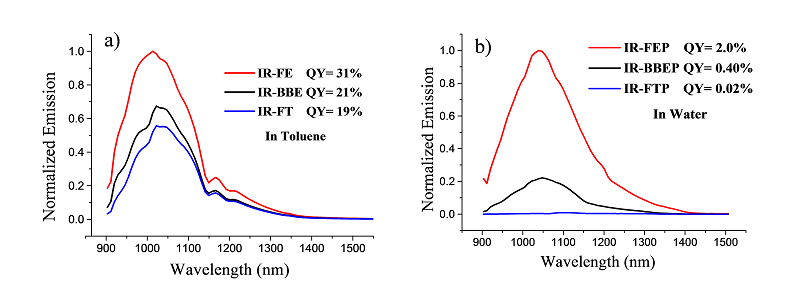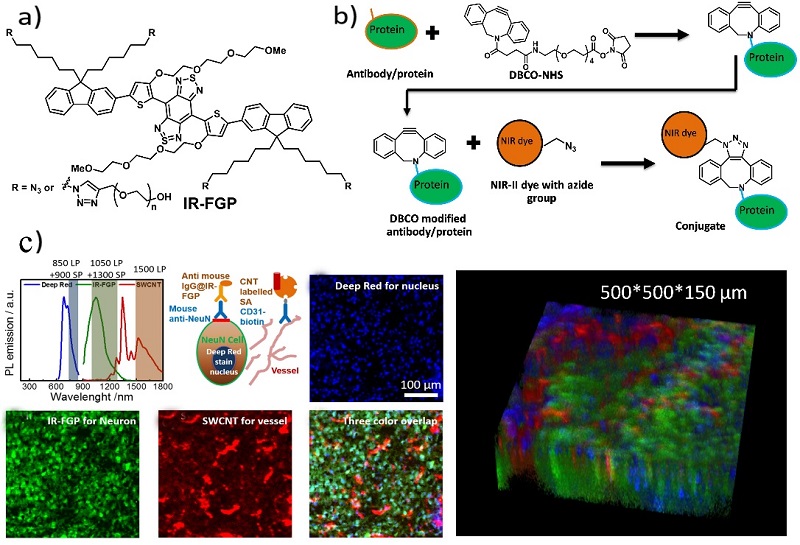Prof. Yongye Liang’s research group has developed advanced molecular fluorophores with enhanced quantum yield for bioimaging in the second near infrared (NIR-II) window and made highly pure fluorophore-antibody conjugates for 3D staining. These works have been recently published in the journal “Advanced Materials” entitled “Rational Design of Molecular Fluorophores for Biological Imaging in the NIR-II Window” and the journal “Proceedings of the National Academy of Sciences” entitled “Molecular imaging of biological systems with a clickable dye in the broad 800-1700 nm near-infrared window”, respectively.
Fluorescence imaging is a versatile modality for biological research and biomedical applications. Compared with the traditional visible or near-infrared window (NIR-I, 750-1000 nm), imaging with fluorescence in the second NIR window (NIR-II, 1000-1700 nm) can provide better spatial resolution/contrast and deeper penetration. The lack of fluorophores with high brightness and biocompatibility is a major bottleneck for the utilization of bioimaging in NIR-II window. In an earlier study, Liang’s group reported a molecular fluorophore, IR-E1, demonstrating renal excretion with emission quantum yield (QY) of 0.70%. Although its QY is among the highest for molecular fluorophores in aqueous solution, enhancing QY is still needed to facilitate imaging with ultrafast speed and optimized imaging depth.
Liang and his coworkers described the rational design of molecular fluorophores with enhanced QY in the study published in “Advanced Materials”. They designed and synthesized a new family of NIR-II molecular fluorophores based on a shielding unit-donor-acceptor-donor-shielding unit (S-D-A-D-S) structure (Figure 1a). The best fluorophore, IR-FE is constructed with 3,4-ethylenedioxy thiophene (EDOT) as the donor, and dialkyl fluorene as the shielding unit. Computational analysis reveals that EDOT can distort the conjugated backbone and tune the electrostatic potential distribution, protecting the BBTD moiety from interactions with solvent and other molecules (Figure 1b). In addition, both the dialkyl-substituted fluorene and the distorted backbone can weaken the intermolecular interactions and reduce the aggregation of the molecular fluorophore. IR-FE exhibits fluorescence emission from 900-1400 nm with a remarkable QY of 31% in toluene (Figure 2a). Upon conjugation with polyethylene glycol chains, IR-FEP demonstrates a QY of 2.0% in aqueous solution (Figure 2b), which is the brightest water-soluble organic fluorophore in the NIR-II region. EDOT is found to play a key role in enhancing the fluorophore QY in aqueous solution.

Figure 1. a) Structure of the fluorophores. b) Schematic of the interaction of solvent molecules with the fluorescent molecule.

Figure 2. a) Fluorescence spectra and quantum yield of the molecular fluorophores in toluene. b) Fluorescence spectra and quantum yield of PEG functionalized molecular fluorophores in water.
In another study published in the journal “Proceedings of the National Academy of Sciences”, Liang and his coworkers utilized the molecular fluorophore as molecularly specific NIR-II probes. They synthesized a clickable fluorophore, IR-FGP, with tert(ethylene glycol) (TEG)-substituted thiophene as the bridging donor unit to improve the solubility and maintain a high QY of 1.9% (Figure 3a). IR-FGP could be efficiently conjugated to molecularly specific proteins or antibodies by click reaction (Figure 3b). Density gradient ultracentrifugation (DGU) separation was further employed to obtain highly pure NIR-II fluorophore-antibody conjugates emitting∼1,100 nm. It facilitated 3D staining of ~170mm histological brain tissues sections on a home-built confocal microscope. By combining with single walled carbon nanotube emitting at 1500-1700 nm and Deep Red emitting in 600-900 nm, they successfully demonstrated the first multicolor molecular imaging across both the NIR-I and NIR-II windows (800-1700 nm) (Figure 3c).

Figure 3. a) Structure ofIR-FGP. b) Schematic ofIR-FGPbinding to target protein. c) 3D tomographic imaging of brain tissues.
Other SUSTech co-authors of the study in “Adv. Mater.” are Dr. Qinglai Yang, Huasen Wang, Dr. Hao Wan, Rui Ma, undergraduate Xiao Zhang and Jingyi Yang. The study was collaborated with Prof. Hongjie Dai’s group from Stanford University, Prof. Haitao Sun’s group from East China Normal University, Prof. Xiaodong Zhang’s group from Tianjin University. Other SUSTech co-authors of the study in PNAS are Dr. Qinglai Yang, Huasen Wang, Dr. Hao Wan, and Wei Huang. The study was collaborated with Prof. Hongjie Dai’s group from Stanford University. These works were supported by the Shenzhen Key Lab funding (ZDSYS201505291525382), the Shenzhen Technical Research funding (JSGG20160301095829250) and the Shenzhen peacock program (KQTD20140630160825828).
Paper link:
Adv. Mater: http://onlinelibrary.wiley.com/doi/10.1002/adma.201605497/abstract
PNAS: http://www.pnas.org/content/early/2017/01/10/1617990114.abstract






